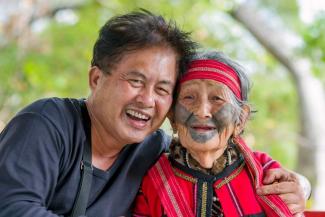
Kimi Sibal with Atayal elder, Jian YuYing (簡 玉英), who has since passed away.
Under a clear mountain sky, an Atayal boy of 13 prepares to transition into a man by way of a painful ceremony passed down by his ancestors. Like many boys his age, he has proven his valor by mastering the art of hunting. In another village, a girl of similar age awaits her own passage into maturity after mastering her craft of weaving. Both wait as a mixture of charcoal and pine tree oil is prepared, applied, and slowly injected into their cheeks and foreheads, a ritual that is part of the most significant coming of age ceremony for the Atayal, one of Taiwan’s 16 recognized Indigenous Tribes. Often referred to as a cultural treasure, the custom of facial tattooing was banned, and subsequently began to disappear, during the Japanese occupation of Taiwan from 1895–1945. “My grandmother had facial tattoos and they were very beautiful,” said cultural advocate and historian Kimi Sibal in a recent interview.
Distributed on both sides of Taiwan’s central mountain range in northern Taiwan, as well as the mountainous areas of Yilan and Hualien, the Atayal Peoples constitute the second largest Indigenous group in Taiwan with a total population of about 90,000 people. Atayal communities are organized into four groups: Tribal organizations (dealing with leadership and property), sacrificial groups (preparing sacrifices and leading ritual proceedings), gaga (a system of ancestral teachings and enforcement of societal norms), and hunting teams.
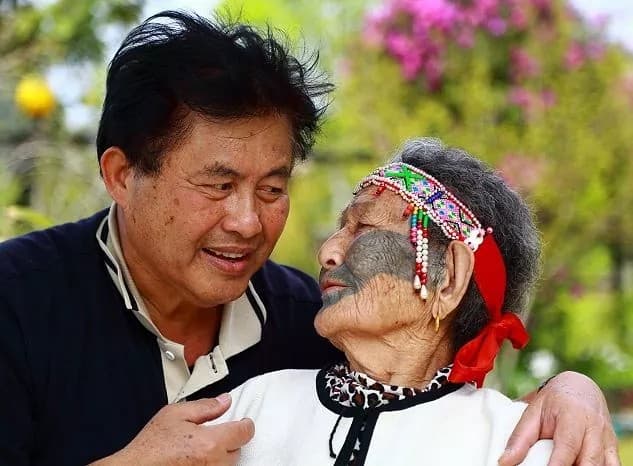
Kimi Sibal with Atayal elder, Jian YuYing, who has since passed away.
“The most distinctive part of the Atayal culture are facial tattoos. While men’s tattoos symbolize adulthood and bravery, women’s tattoos symbolize skilled weaving,” says JunYu Lin (Atayal), a 33-year-old music teacher in Yilan. The Atayal Tribe uses ramie, a flowering plant in the nettle family, as raw material for weaving. These days, most people use wool to weave due to its convenience and color diversity, so the traditional use of ramie is gradually declining. “A girl who cannot weave and has no tattoos would likely not be able to find a husband in the Tribe,” explains Lin.
After the conclusion of the Sino-Japanese war, the Japanese signed the Treaty of Shimonoseki and rose to power. In an effort to exercise authority over a group seen by colonizers as savage, Indigenous communities living in the mountains were driven to flatter land, where they were easier to regulate and control. Once the Japanese fell from power after World War II, Chiang Kai-Shek and the Kuomintang (KMT), a major political party in Taiwan, filled their position of sovereignty. With the goal to create a strong national Chinese cultural identity, the new authoritarian administration continued the pattern of oppression and maltreatment towards Indigenous Peoples.
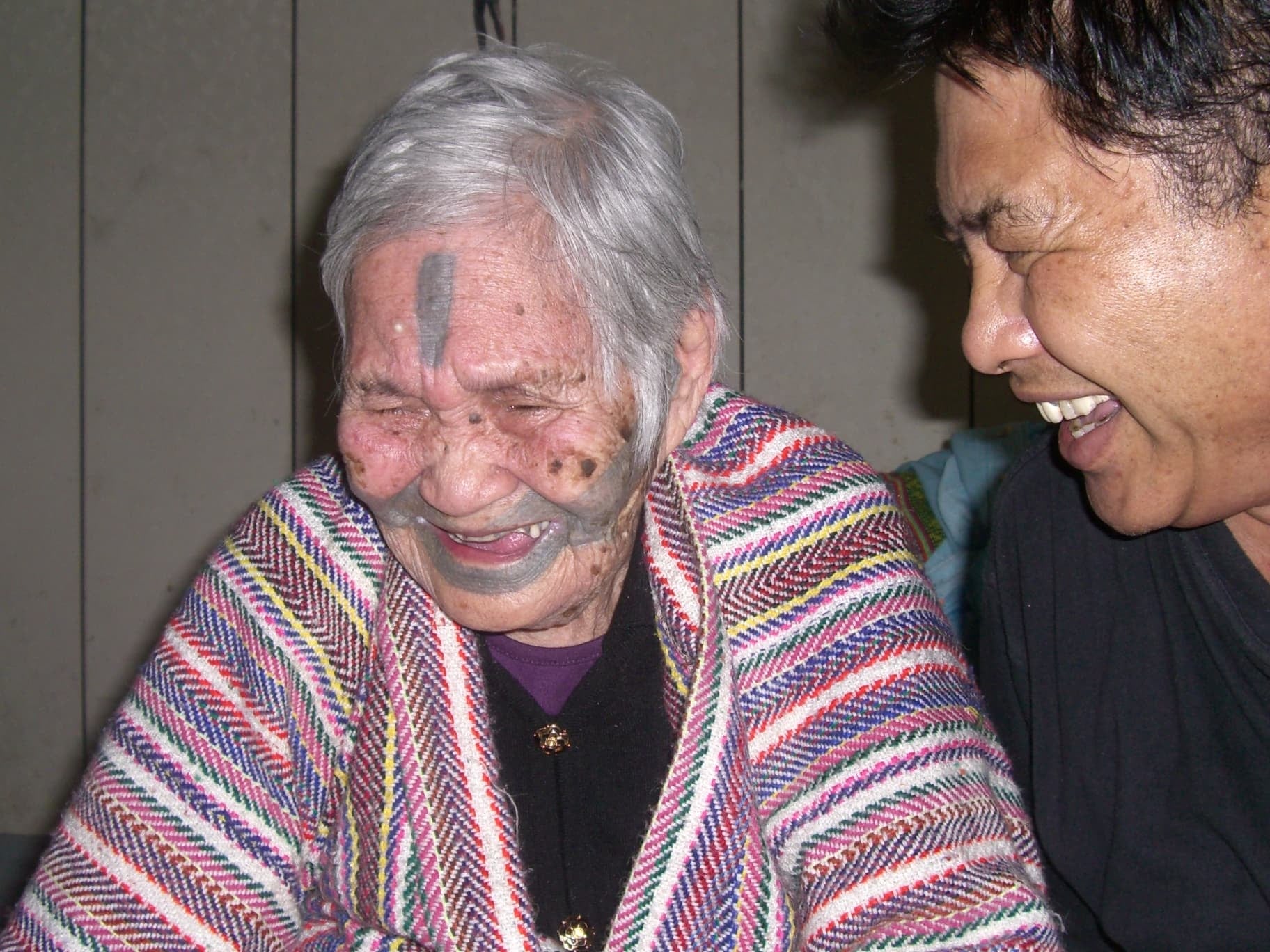
Kimi Sibal with Taroko elder, Lin Zi Li (林梓 里), who has since passed away.
Japanese schools were replaced by those run by the KMT, and due to education reform regulations, all Indigenous people were required to learn Mandarin. However, the Chinese were not required to learn any of the Indigenous languages. Not long after, all Indigenous languages, as well as Japanese, were banned from public use. It was not until after the lift of KMT martial law in 1987 and the subsequent democratization of Taiwan that those languages that previously faced systematic oppression began to resurface.
In the midst of numerous pacification techniques and prolonged persecution, sacred practices such as facial tattooing were prohibited. After years of oppression, Sibal’s grandmother had been conditioned to be ashamed of the markings on her face. As a Hualien native and a member of the Truku community, Sibal did not learn about his heritage until much later in life. He recalls an incident involving his son when he first began school that awakened him to the importance of learning about his background. The boy got into a fight with his classmates because they targeted his heritage, sneering that the tattoos worn by his ancestors made them look like monsters, and that he was from a bloodline of savages. Sibal resolved to discover the story behind his own ancestry, and to share the true meaning behind the custom of facial tattooing.
“I took my camera, I took my voice recorder and I set out. At that time, I found that there were still many people who had tattoos,” he says.
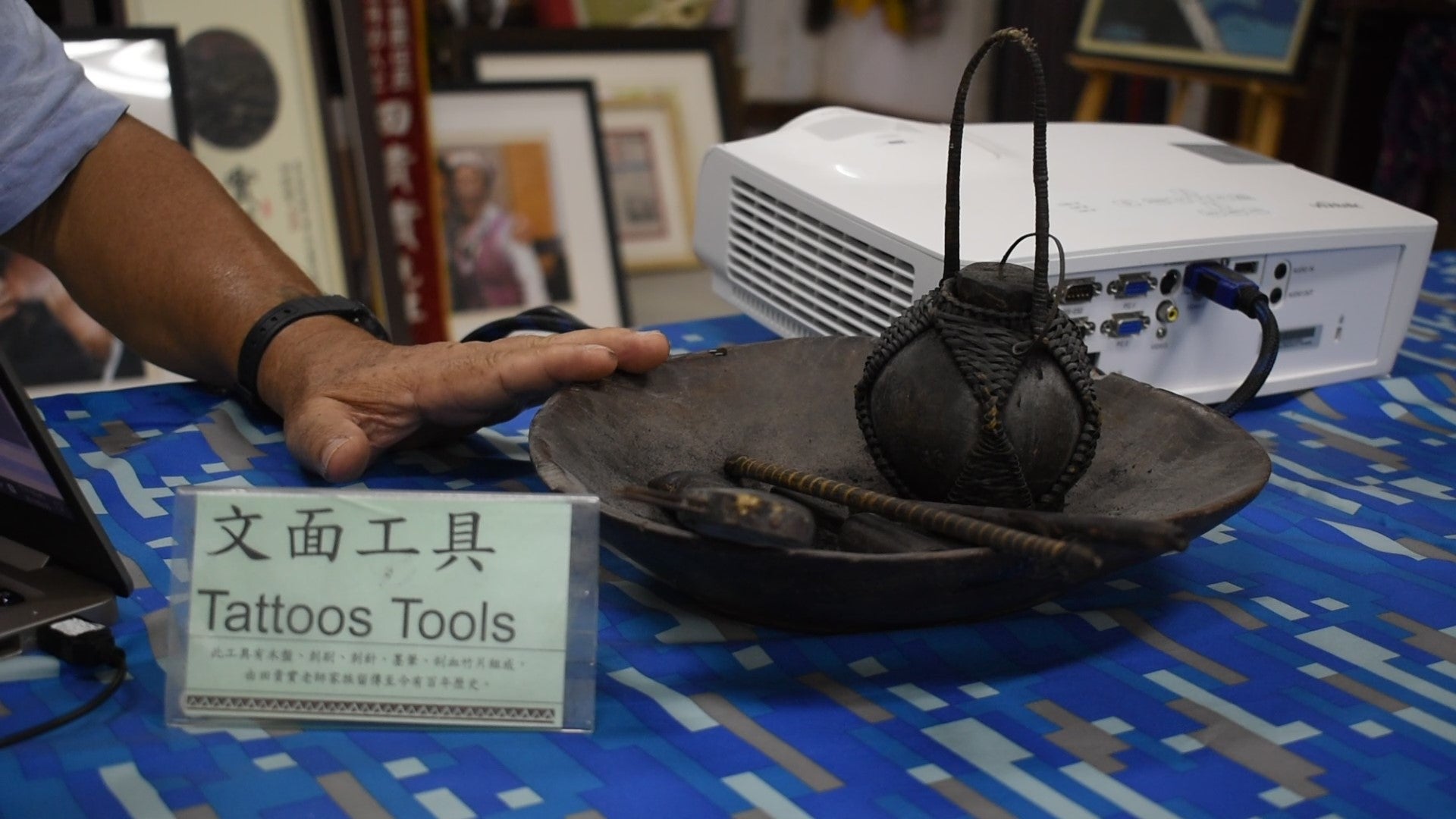
Ancient tools used for facial tattooing, atok (a needle-bearing stick) is driven into the skin using a totsin (hammer).
Sibal has since dedicated years of his life to the documentation of this sacred practice, and displays an extensive collection of his work in Hualien. Today, there are no remaining Atayal elders with facial tattoos. “I came to think, why have I been researching these people for all these years? Well, the words they speak are filled with history. The words they speak are rich and wonderful. After years of research, I finally began to realize why thousands of people passed down these tattoos, their meaning and their spirit,” he says.
Sibal has captured hundreds of portraits of tattooed elders and has written many books about this symbolic custom. He lists four main reasons for the preservation of facial tattoos: Tribal recognition, protection against evil spirits, access to the afterlife, and beauty. Although the meanings behind these facial tattoos are representative of honor and high achievement, with the advent of colonization, they have often been misinterpreted. As Sibal’s son discovered at school, it is common for groups that practice facial tattooing to be falsely marked as uncivilized and criminal.
In modern society, Indigenous populations around the globe face many challenges. Some of these difficulties include arguments over land rights, discrimination, low access to education and health services, language hegemony, and poverty. One prevalent issue faced by Taiwan’s Indigenous Peoples has been unemployment. Since the government began allowing the import of minimum wage-earning foreign laborers in the 1990s, Indigenous populations have struggled to compete for a living wage. The Indigenous Peoples Employment Rights Protection Act of 2001 was designed to alleviate the high unemployment rates of Indigenous Peoples. It includes a proportionate recruitment principle, which states that at least one-third of the workforce employed by government, public schools, or State-run business must be Indigenous. The act includes other guidelines, such as guidance for Indigenous people to form a cooperative.
As Taiwan continues to develop as a colonized nation, many Indigenous people have abandoned their traditional lifestyle for one of modernity. Recently, the number of Indigenous Taiwanese living in urban centers has surpassed the number of Indigenous people living in rural areas for the first time. By a small percentage, most Indigenous people now live in Taiwan’s cities. Taiwan’s Indigenous youth have to make a serious effort to recover their Indigenous identity; they must seek out resources to learn their language and go back to their villages to try to understand their culture, which is not often taught in schools.
Although Indigenous society has been threatened for decades, a number of policies have recently been introduced to protect these integral cultures and provide resources for their survival. One such example is the establishment of the Indigenous Peoples Cultural Foundation in 2007, whose mission is to “pass down the legacy of culture and education of Indigenous Peoples as well as to operate a media industry promoting Indigenous cultures.” Another notable policy development is the Indigenous Language Development Act of 2017, which aims to secure Indigenous language use. The Act officially names the languages of Taiwan’s Indigenous Tribes as national languages. Moreover, the government is required to organize a foundation dedicated to the research and support of Indigenous languages.
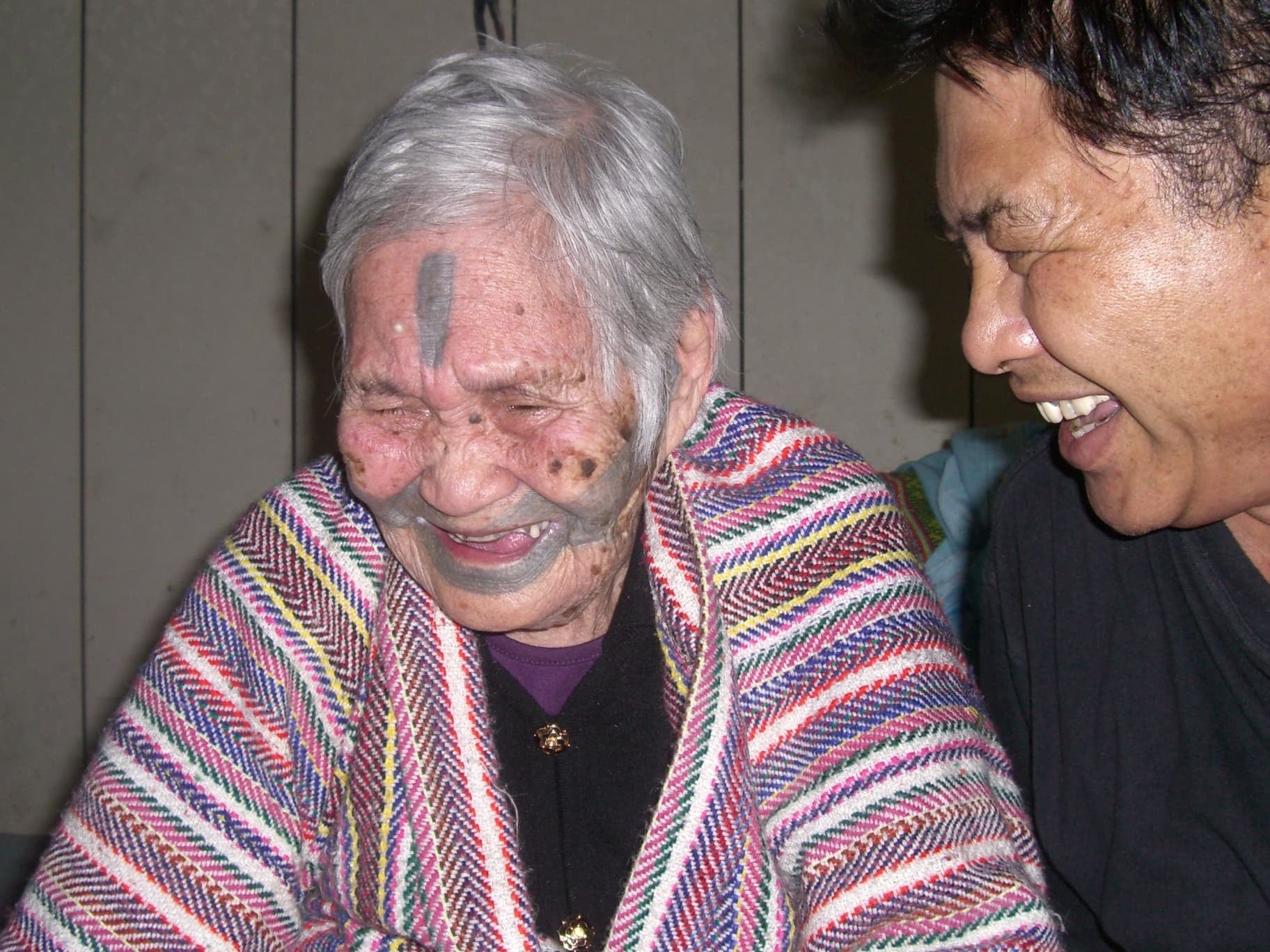
Kimi Sibal with Taroko elder, Lin Zi Li (林梓 里), who has since passed away.
According to the Act, Indigenous languages are permitted to be used in legal affairs, official documents, and signage in Aboriginal areas. Furthermore, it is mandatory for State-run Indigenous media outlets to produce programs and publications for promoting and teaching Indigenous languages. Although the Taiwanese government has taken steps to promote Indigenous rights, such as increased Tribal recognition, government representation, and protective legislation, progress has been slow, and there is much work to be done.
Through his work documenting the lives of Atayal elders, Sibal’s legacy will remain for many years to come. “As long as we are here, no matter what we do, we are not treated fairly on this earth,” he says. “There is no mutual respect. What others write about our culture, about our language, is in the eyes and interpretation of the government. They can write whatever they want, but today I am doing this honorable work because the ones that have these tattoos are my own ancestors. The most important thing is for these tattoos to be recorded. We must let the next generation know that the markings their ancestors have on their face represent bravery and capability.”
—Sylvia Dean is public relations coordinator for Indigenous Bridges-ATAYAL, a Taiwanese organization working to facilitate Indigenous cultural revival by connecting Indigenous communities as a “bridge.”
